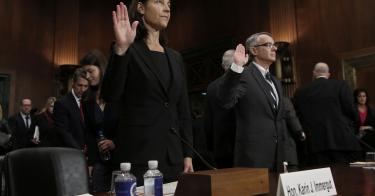In a 1993 dissenting opinion, Justice Antonin Scalia compared one of the Supreme Court’s made-up legal doctrines to a “ghoul in a late night horror movie that repeatedly sits up in its grave and shuffles abroad” no matter what is done to kill it. Beware: Entering the presidential election season means that ghouls will start shuffling their way through the judicial confirmation process.
One of those is the so-called “Thurmond Rule.” It is cited by those who want to restrict, or even cut off, confirmation of judicial nominees in a presidential election year.
Don’t think it’s too early to be addressing such things. Sen. Patrick Leahy, D-Vt., who, according to the Congressional Research Service, is the “senator who most frequently has asserted the existence of a Thurmond rule,” began talking about it 20 months before the 2012 election.
Two things are certain: The Thurmond Rule is not a rule, and it did not originate with Sen. Strom Thurmond, R-S.C.
The Congressional Research Service describes the Thurmond Rule as a “past Senate practice” or an “informal Senate understanding” that confirmation of lower court nominees drops off and ends “earlier in presidential election years than in other years.” Beyond that very general description, it’s hard to get a handle on just when this practice/understanding begins and what it actually is.
With a Democrat in the White House, for example, Leahy has said that the Thurmond rule applies “at the end of presidential election years,” “within a couple months of a presidential election,” or in “the last few months of [a president’s] term in office.”
But with a Republican president, Leahy has said that June of a presidential election year is “way past time” for the Thurmond rule, that it “kicks in” around April or “after the spring.”
Similarly, under a Democrat president, Leahy says the Thurmond rule means that “we might slow things down,” while under a Republican president it means “no judges” or that “the president … except for extraordinary exceptions … does not get a nominee through.”
Whenever it applies and whatever it means, the Thurmond rule did not originate with Thurmond. The label first appeared in 1992, when Democrats anticipated that Bill Clinton would win the election and wanted a legitimate-sounding excuse for keeping judicial vacancies open. Sen. Howard Metzenbaum, D-Ohio, claimed that Thurmond “was the leader in shutting down entirely the question of judicial nominees in 1980.”
As the New York Times reported, that is exactly what Democrats did in 1992. Then-Judiciary Committee Chairman Joe Biden, D-Del., for example, refused to hold a hearing for more than 50 of President George H.W. Bush’s judicial nominees.
Four years later, Biden picked up the Thurmond rule mantra, claiming Thurmond had said “there will be no more judges, period … and shut down the whole process at the end of May.” Two presidential election years later, Leahy kept the story going by claiming that “Sen. Thurmond … instituted a policy to stall President Carter’s nominations.”
And so, the “Thurmond Rule” was born. The problem with this tale is that it just ain’t so.
The judicial confirmation process did not shut down in May, or at any other time, in 1980. In fact, the Senate confirmed more judges in 1980 than in all but one presidential election year in history. It confirmed a higher percentage of them after May, when Biden said the process stopped, than in all but one presidential election year since the turn of the 20th century.
Even more strikingly, President Jimmy Carter nominated Stephen Breyer to the U.S. Court of Appeals after Democrats lost both the White House and Senate in the 1980 election. At the Judiciary Committee’s business meeting on Nov. 25, 1980, it was Thurmond who moved that the nomination be approved, which the committee did without objection.
The Senate confirmed Breyer on Dec. 9, 26 days after his nomination, one of the swiftest confirmations ever. Far from engineering a confirmation shutdown (from the minority, no less), Thurmond helped make 1980 only the second election year in history in which the Senate confirmed a judicial nominee after the minority party captured both the Senate and the White House.
No, the notion that judicial confirmations shut down early in 1980, let alone that such a move was led by Sen. Thurmond, is pure fiction. This fantasy may be politically useful, but it’s a fantasy nonetheless.
The Thurmond rule isn’t a rule, and if we really follow Thurmond’s example, the Senate will press ahead and confirm judicial nominees until the very end of the 116th Congress.
This piece originally appeared in the Washington Examiner




